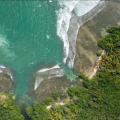Searching for Godzilla
Brett Gonzalez and his colleagues dive deep into lightless caves to find some of the world’s rarest invertebrates—including some unknown to science.
As legend has it, the monster Godzilla lives in the ocean near Japan. from which it periodically emerges to wreak havoc on models of Tokyo. Godzilla’s namesake, Godzillius robustus, is considerably less threatening. A blind, saltwater crustacean known as a remipede, G. robustus thrives in a much different environment: one dark water-filled cave on North Caicos Island in the Lucayan Archipelago (Bahamas + Turks and Caicos).
First discovered and named in 1986, specimens of G. robustus were collected again last year by Smithsonian invertebrate zoologist Brett Gonzalez and colleagues during an expedition sponsored by the Smithsonian’s Global Genome Initiative. G. robustus is one of a diverse community of crustaceans, annelids and other invertebrates specially adapted to caves on the Turks and Caicos Islands.
The true diversity of invertebrates in these caves was discovered only recently, in the 1980s, when scientific divers began to fully explore these flooded underwater worlds. One of the primary purposes of Gonzalez’s trip was to collect a rare cave scale worm, Pelagomacellicephala iliffei, for transcriptome sequencing and highspeed videography. Simultaneously, they were also collecting all other cave specimens so their DNA barcodes could be added to the Global Genome Initiative’s database.
“Many of the animals we brought back had been previously collected and described, physical specimens collected years ago that are in the National Museum of Natural History collections. They were acquired, however, before any genetic barcoding information was being taken,” says Gonzalez, who works at the museum.
“Important and rare invertebrates live in caves on these islands – having their DNA can finally help answer scientific questions about the origins of certain invertebrate groups. They could be the missing link or puzzle piece in our understanding, so part of our mission was to collect known specimens for their DNA,” Gonzalez continues.
In addition to a number of previously described species, Gonzalez and his team brought back three species–two annelids and one remipede—that were new to science. “For animals we thought were new to science, we took extra care to make sure we brought back enough material for both genetic and morphological analyses, allowing us to photograph and examine them under microscopes, describe and illustrate what they look like.”
The Torch caught up with Gonzales, lead author of a recent paper in the International Journal of Speleology (scholarcommons.usf.edu/ijs/vol49/iss2/1/) to learn more about diving into these lightless caves and and the invertebrates that live there.
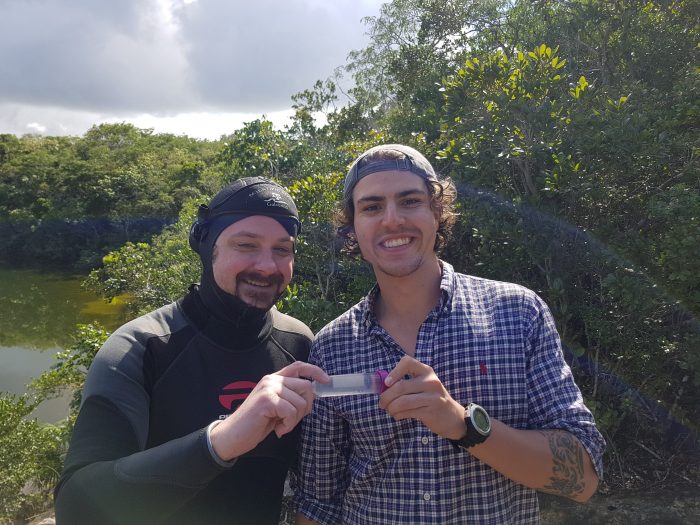
Brett Gonzalez, left, and Marc Allentoft-Larsen, from the University of Copenhagen, Denmark together hold a rare cave scale worm, they had been trying to collect for more than a week. Gonzalez finally collected the specimen on his second two-hour dive to more than 150 feet the day of this photo.
What kind of caves did you collect in?
We dove in water-filled caves that formed long ago in the porous karst limestone terrain, caves with names such as Airport Cave, Old Blue Hill Cave, Snake Cave, Conch Bar Cave and Cottage Pond, to name a few. These inland caves are known as ‘anchialine caves,’ being connected to the open ocean through the pore spaces in the surrounding carbonate rock. The ocean water and water in the cave interacts constantly, fluctuating with the tides and moving back and forth carrying nutrients, oxygen and other water-borne compounds.
Marine animals such as small crustaceans, worms and fish live in and traverse these connecting waterways, but they are seldom wide enough for a human diver to pass. Interestingly, cave animals are only known from within these caves and are never seen in the open ocean. They have no defense mechanisms for an illuminated world.
Are anchialine caves filled with salt or fresh water?
Normally they contain three water layers. Freshwater is on top, which is rainwater that accumulates underground. At the bottom is the marine layer, made up of the intruding saltwater from the surrounding marine environments, entering through the porous limestone rock. As a cave’s location gets farther away from the ocean the saltwater layer gets deeper, and in some locations around the world, we can’t dive deep enough to reach it.
The fresh and saltwater layers are separated by a mixing zone of brackish water called a halocline. This is an important layer because it traps nutrients for animals to feed upon, being a boundary layer between the fresh and saltwater layers that animals sometime use to escape predators. There are also highly specialized invertebrates that have adapted to live in this brackish water layer.
I focus primarily on animals that live in the marine layer, but for this project we were collecting invertebrates from all three layers, basically wherever we could find them.
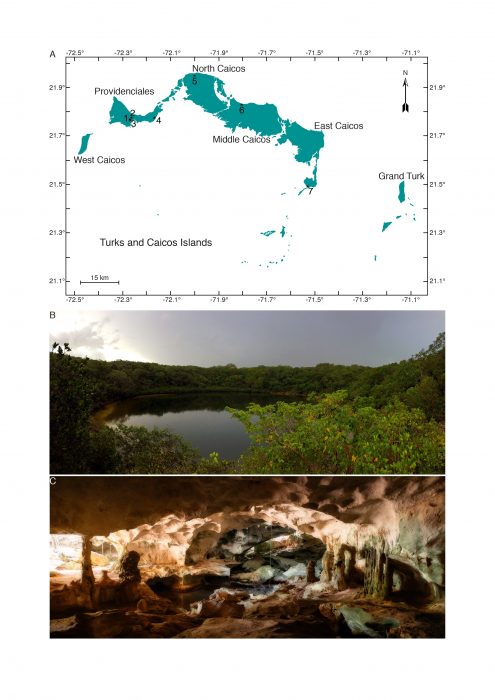
Turks and Caicos Islands with examples of cave systems found throughout the islands. (A) Islands of the Turks and Caicos with known cave locations mapped: 1. Airport Cave, 2. Old Blue Hill Cave, 3. Snake Cave, 4. The Hole, 5. Cottage Pond, 6. Conch Bar Cave, 7. The Fountain. (B) Cottage Pond, North Caicos Island. Photo by Brett C. Gonzalez. (C) Conch Bar Cave, Middle Caicos Island. (Photo by Joost Daniels.)
Isn’t it dangerous to dive in these caves?
As a whole, all diving is a dangerous activity, both for sport and as a tool for research. Personally, I think it is safer though than open water diving, its more predictable! It takes a lot of training to become a cave diver, incorporating a lot of tools and techniques to make it safer.
For example, we are always following or laying a continuous nylon guideline that leads directly to the water’s surface so we can follow it out to unobstructed open water at any time. Directional markers are also placed when navigation becomes complicated or when multiple lines are present, always pointing towards the exit.
We also use different modes of redundancy, for example we have multiple air tanks, multiple regulators for breathing, multiple dive computers, safety reels and always three sources of light, so if something were to fail down there, we always have a backup.
We always dive in teams of two or more, so we also have the redundancy of a buddy system if something happens. In a dive team we always expect someone to be there to help, but cave training prepares us to be self-reliant always.
We also factor in decompression time into our total dive time, as some of these dives last over two hours. This is the time required for your body to normalize from a buildup of gasses in your bloodstream before you surface. Every cave dive follows the rule of thirds: we use one-third of our total air supply to go into the cave to conduct our scientific work, we use one-third to come back and we keep one-third in reserve in case of emergency. We never break that rule.
Careful planning and gear checks are required before every dive, but it keeps it safe.
What invertebrates do you see the most in these caves?
In general, most of the invertebrates we find in anchialine caves are crustaceans–anything from shrimp to tiny copepods, as well as isopods and amphipods. We also usually find annelids, which are marine bristle worms. Annelids are a large group that also includes the distantly related earthworms and leeches.
There are a lot of morphological differences between and within the animals for each of these groups, but when we look at generalities of animals living in caves, we typically see animals lacking or with reduced eyes, little to no pigmentation and elongated sensory structures. Crustaceans also have thinner cuticles. Morphological identification is different for each animal, some having characteristic features throughout their entire body, others with identifying features only found in specific parts, like their head or legs.
Cave adapted worms are generally very different from worms not found in caves, even if they are closely related. One of the biggest differences is that most worms in caves have adapted to the water column, transitioning from crawling to swimming. They are often blind, without pigment and have elongated sensory appendages, similar to what we see in crustaceans. This type of morphology would make them susceptible to predators in the open ocean, but in a cave, they are perfectly suited.
Of course, we find other animals in these caves, but very few are cave adapted, most are what we call ‘accidentals’ that have wandered in or were brought in by the exchanging tides. Their success however is usually short lived. Occasionally sea stars (enchinoderms) will survive, but it’s rare. There are also cave adapted vertebrates too, like fish and eels, but only in certain locations around the world.
The Turks and Caicos Islands are not known for blind cave fish or blind cave eel populations. Terrestrial animals like turtles or other fish are seen sometimes in the entrance pools to caves, but it is only because it is an illuminated aquatic environment. They aren’t adapted to a cave environment.
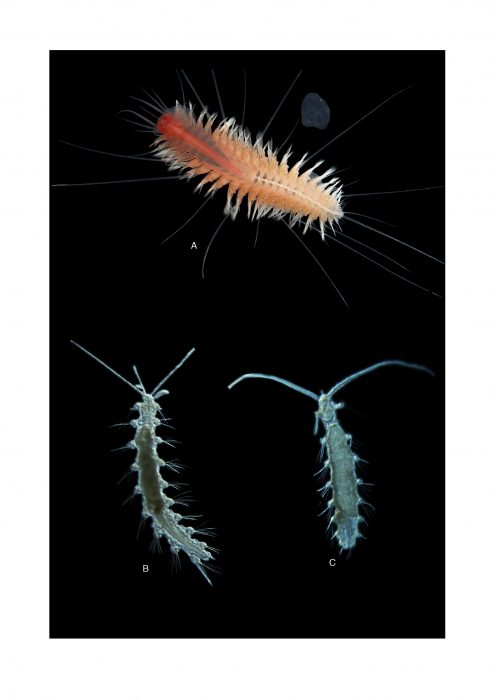
Anchialine annelids of the Turks and Caicos Islands. (A) Pelagomacellicephala iliffei. (B) Mesonerilla sp. (C) Speleonerilla sp. Photos by Jørgen Olesen, Brett C. Gonzalez and Katrine Worsaae. Images not to scale.
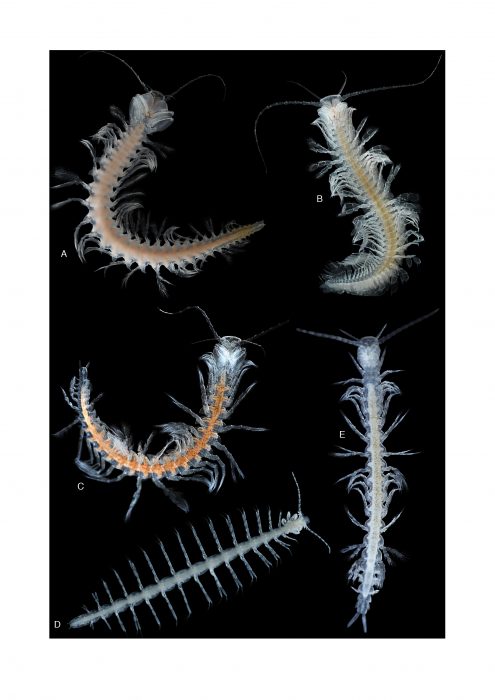
Remipedes of the Turks and Caicos Islands. (A) Godzillius robustus. (B) Kaloketos pilosus. (C) Lasionectes entrichoma. (D) Micropacter yagerae. (E) Remipedia sp. nov. All photos by Jørgen Olesen (Natural History Museum, University of Copenhagen, Denmark). Images not to scale.
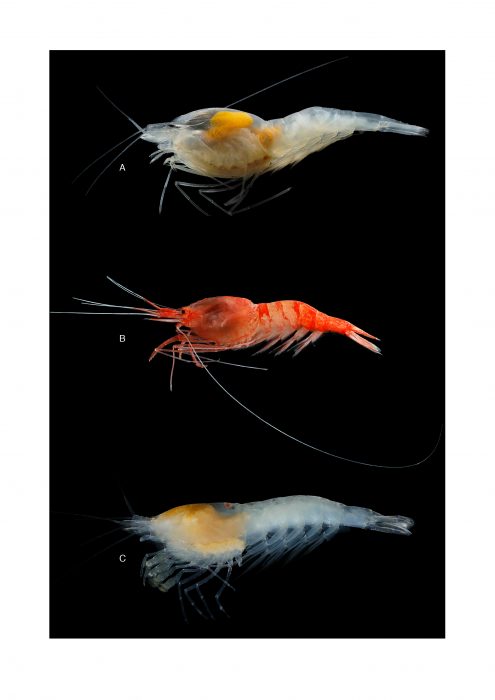
Anchialine decapods of the Turks and Caicos Islands. (A) Agostocaris williamsi. (B) Barbouria cubensis. (C) Typlatya garciai. Photos by Sarit Truskey and Brett C. Gonzalez. Images not to scale.
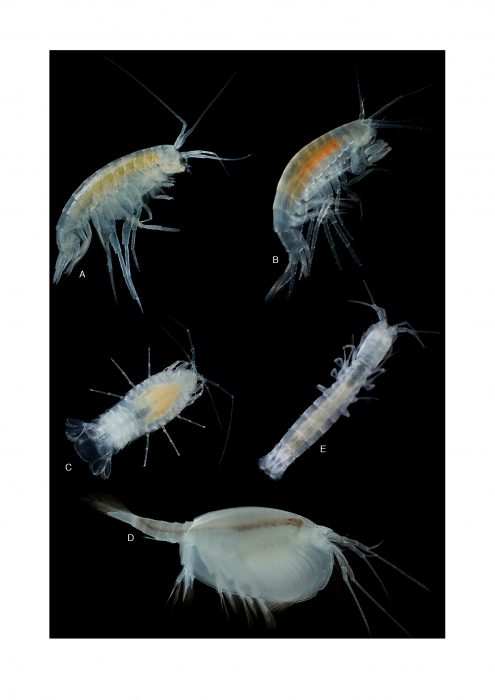
Assorted anchialine crustaceans of the Turks and Caicos Islands. (A) Bahadzia stocki. (B) Spelaeonicippe provo. (C) Bahalana caicosana. (D) Speonebalia cf. cannoni. (E) Stygiomysis clarkei. Photos by Jørgen Olesen, Sarit Truskey and Brett C. Gonzalez. Images not to scale.
Are these caves protected?
A vast majority of caves have some local protections, but they are not as strong as they could be. Unfortunately, some of these cave entrances have been used for dumping of trash for decades. Basically, it’s a dark hole and people don’t care what happens or where the trash goes. In many Caribbean cave localities there is a mentality of ‘out of sight, out of mind’, but we are working to change that. Obviously, it does have a negative impact that spreads from one cave system to the next because the caves are all interconnected.
There are examples in the Bahamas and even Florida were people have dumped substances into a cave in one area of an island, and weeks later, other wells or caves on other parts of the island became polluted too. In impoverished areas cave openings are sometimes used for bathing and camps form around them.
Single cave ‘die offs’ of animals have been known throughout the Lucayan Archipelago and are often traceable back to changes in groundwater use or water pollution. During our trip, one cave known as Airport Cave was found to be devoid of life, likely due to exhaustion of oxygen from the water. The exact cause is unclear, but several possibilities exist.
This is one reason our work is so important. Biological diversity changes and diversity is lost. Acquiring a comprehensive inventory of the genetic material on these islands is critical. The crustaceans and the worms in the caves on these islands are very important groups that can really start to answer questions about the evolution and adaptation of larger groups of animals.
The project was a huge collaboration between a number or organizations. The funding GGI provided allowed us to form a team of experts from all over the world.
(Karen Osborn, curator of annelids and peracarids at the Smithsonian’s National Museum of Natural History, and Sarit Truskey, a research intern at the Natural History Museum, were the other Smithsonian co-authors of this study.)
Posted: 15 June 2020
-
Categories:
Feature Stories , Natural History Museum , Science and Nature
